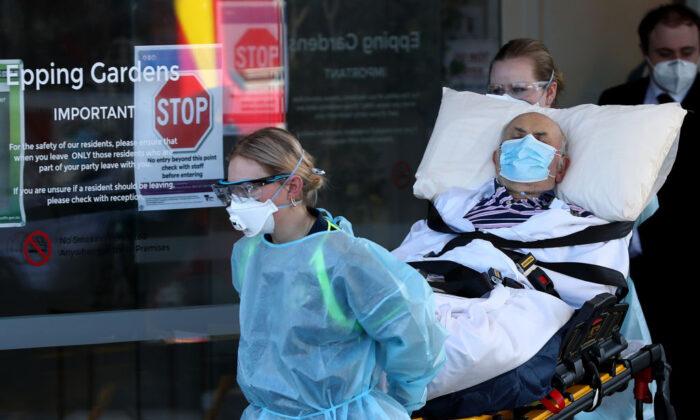Victoria will boost measures to protect health, aged and disability workers with new data showing most who are infected with COVID-19 contracted it on the job.
The new data is at odds with Premier Daniel Andrews’ suggestion on Aug. 12 that the majority of healthcare workers were “acquiring coronavirus outside of the workplace.”
But Victorian chief medical officer Andrew Wilson clarified that assertion, saying it was based on statistics from the state’s first wave of the virus.
Then, only 22 percent of healthcare cases were believed to have caught it at work.
“At the time, that was the data, that was the information that we had,” he told reporters on Aug. 25.
“This has been very quick, this wave. It’s happened over a few weeks.
“It takes more than a few days to untangle the cases because they’re happening at the same time.”
Two-thirds also could be underselling the scale of on-site health worker infections, as it rises to 86 percent when cases still under investigation are not counted.
It’s likely those cases will tell a “very similar story,” Wilson said.
“Poor infection practice has probably been the main driver of infection,” he said.
“There have also been issues about aged care workers moving between different facilities.”
Other leading causes of infection in the health sector were shared spaces, substandard PPE use and ageing ventilation systems.
Aged care workers (674) and nurses (497) represented 88 per cent of all healthcare-acquired cases from July 1 due to their large workforces and close contact with patients, Wilson said.
Under the state’s updated strategy to combat the problems, every health service in Victoria will introduce “personal protective equipment spotters” and study potential aerosol transmission hotspots.
They will also trial “fit testing” for high-risk staff to ensure virus particles cannot penetrate safety gear, while a newly-established PPE taskforce has recommended the use of N95 masks in emergency departments, COVID-19 wards and aged-care sites.
Wilson said some outbreaks had been directly related to the incorrect storage of PPE and potential contamination by aged care residents.
Every health service across the state will also be required to self-assess staff amenities to ensure they meet minimum standards for physical distancing, cleanliness and infection control.
Health Minister Jenny Mikakos said break rooms deemed too small to allow workers to eat and drink safely would be replaced by marquees and other temporary set-ups.
But the Australian Medical Association scorned the state government’s response, saying it showed they still weren’t taking the issue seriously. AMA president Omar Khorshid described it as “too little, too late.”
“Australia had the chance to act, but is now playing catch-up in its efforts to protect frontline staff,” he said in a statement.





